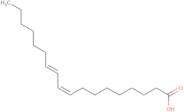(9Z,11E)-9,11-Octadecadienoic acid
CAS: 2540-56-9
Ref. 3D-FO158178
| 10mg | Descatalogado | ||
| 25mg | Descatalogado | ||
| 50mg | Descatalogado | ||
| 100mg | Descatalogado | ||
| 250mg | Descatalogado |
Información del producto
- 9,11-Octadecadienoic acid, (9Z,11E)-
- 9,11-Octadecadienoic acid, (E,Z)-
- 9,11-Octadecadienoicacid, (E,Z)- (8CI)
- 9-cis,11-trans-Linoleic acid
- 9-cis,11-trans-Linoleicacid
- 9-cis,11-trans-Octadecadienoic acid
- 9Z,11E-Octadecadienoic acid
- Bovinic acid
- Bovinicacid
- Conjugated (9Z,11E)-Linoleic acid
- Ver más sinónimos
- Rumenic acid
- cis-9,trans-11 Conjugated linoleic acid
- cis-9,trans-11-Octadecadienoic acid
- trans-11-cis-9-Octadecadienoic acid
The major fatty acid in the cell membrane of L. acidophilus is (9Z,11E)-9,11-octadecadienoic acid. This fatty acid can be synthesized by bacteria and is not found in plants or animals. The bioavailability of this fatty acid is low due to its low solubility in water. It has been suggested that dietary supplementation with (9Z,11E)-9,11-octadecadienoic acid may have beneficial effects on inflammatory diseases such as rheumatoid arthritis and inflammatory bowel disease. It also has been shown to be a potential anticancer agent and to inhibit tumor growth in animal models. Lactobacillus species are fermenters and grow at a pH range between 4.5-6.5 without oxygen with the help of growth factors like lipopolysaccharide and glucose for energy production.





